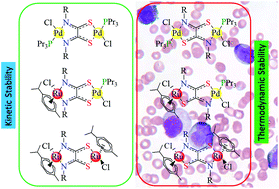Ruthenium(ii) and palladium(ii) homo- and heterobimetallic complexes: synthesis, crystal structures, theoretical calculations and biological studies†
Abstract
Four Ru–Pd heterobimetallic complexes, each one in two different coordination modes (NNSS and NS) having metals connected by a binucleating dialkyldithiooxamidate [N(R)SC-CS(R)N] [R = methyl, ethyl, n-butyl and isopropyl], were prepared by reacting the monochelate [(trinpropyl-phosphine)ClPd(HR2C2N2S2 κ-S,S-Pd)] with [(η6-p-cymene)RuCl2]2. Furthermore, two palladium homobimetallic complexes having two (trinpropyl-phosphine)ClPd moieties joined by a diethyldithiooxamidate in both κ-N,S Pd, κ-N′,S′ Pd′ and κ-N,N′ Pd, κ-S,S′ Pd′ coordination modes were synthesized. For both kinds of complexes, homo- and heterobimetallic, at room temperature and in chloroform solution, the NNSS coordination mode (kinetic compounds) turns out to be unstable and therefore the resulting complexes rearrange into a thermodynamically more stable form (NS coordination mode). The crystal structures of [(trinpropyl-phosphine)ClPd]2[μ-(ethyl)2-DTO κ-N,S Pd, κ-N′,S′ Pd′] (2) and [(η6-p-cymene)ClRu][μ-(methyl)2-DTO κ-N,S Ru, κ-N,S Pd] [(trinpropyl-phosphine)ClPd] (1c) were determined by solid state X-ray crystallography. Moreover, the higher stability of the thermodynamic species in the heterobimetallic complexes (Ru–Pd) was evaluated by means of computational studies in accordance with the maximum hardness principle. All stable NS complexes (i.e.1c–4c, 2 and the previously reported homobimetallic Ru complex 3) were tested against two leukemia cell lines, namely the drug-sensitive CCRF-CEM cell line and its multidrug-resistant sub-cell line CEM/ADR5000 showing anti-proliferative activity in the low micromolar range (∼1–5 μM) and micromolar range (∼10–25 μM), respectively. In addition, these complexes efficaciously block at least two out of the three proteolytic activities of the tumor target 20S proteasome, with heterobimetallic complex 3c and homobimetallic complex 3 possessing the best inhibitory profile.



 Please wait while we load your content...
Please wait while we load your content...